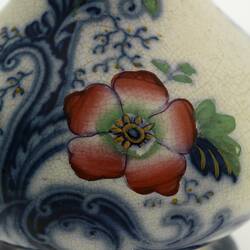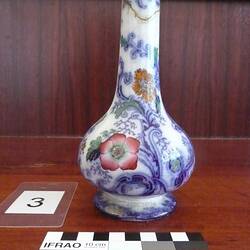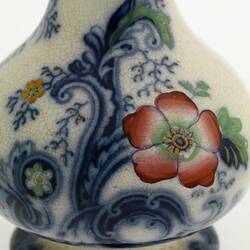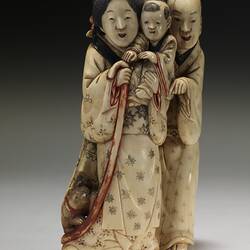Summary
Ceramic vase decorated with a blue transfer print and hand painted floral pattern, manufactured in Europe, circa 1880.
While the use of blue and white ceramic decoration was well established in Europe by the nineteenth century, the pattern design illustrates the clear Chinese origins of this style of ceramic ware.
Appearing in Europe in the sixteenth century, often with both Oriental as well as Islamic influence in design, the production of blue and white procelain ware increased in the seventeenth and eighteenth centuries in the major northern European procelain centres of Meissen in Germany and Delft in the Netherlands.
Blue and white procelain ware was extensively copied across Europe, including in England where the style is often referred to as 'English Delftware', a term that clearly highlights the influence the Dutch production had on other European manufactures.
Physical Description
Cylindrical neck above bulbous body with foot. Blue transfer printed foliage on vase decorated with hand painted flowers and leaves. Damage to neck (repaired) and foot.
More Information
-
Collection Names
-
Collecting Areas
-
Acquisition Information
Cultural Gifts Donation from Dr Will Twycross, 23 Jan 2009
-
Acknowledgement
Donated through the Australian Government's Cultural Gifts Program
-
Place & Date Made
-
Place & Date Exhibited
Royal Exhibition Building (REB), Nicholson Street, Carlton, Greater Melbourne, Victoria, Australia, 1880-1881
-
Collector
Mr John Twycross, Elsternwick, Greater Melbourne, Victoria, Australia, 1881
-
Classification
Royal exhibition building, International exhibitions, Exhibition heritage
-
Category
-
Discipline
-
Type of item
-
Overall Dimensions
90 mm (Width), 180 mm (Height)
-
Keywords
Ceramics, Decorative Arts, Exhibitions: Melbourne International, 1880-1881, Royal Exhibition Building






